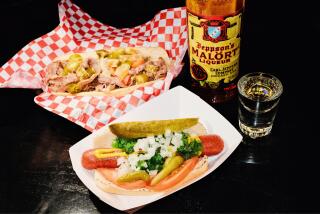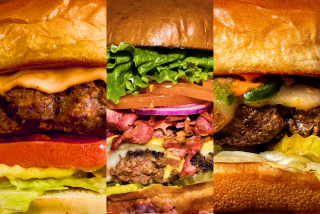An American Icon
- Share via
The cookbooks most flamboyantly draped with Americana have a curious tendency. While unashamed of offering curiosities such as “grits souffle,” they neglect one of the most popular foods that Americans actually eat: the hot dog.
Turn to the index of “American Food: The Gastronomic Story” and there is no mention of it. Switch to “The USA Cookbook” and still no hot dog. How about “Honest American Fare?” Not a dog.
This is akin to a rock ‘n’ roll Hall of Fame without Elvis. The hot dog is nothing less than a 20th century American icon.
Purists might argue that it is actually Austrian, or German, or both. In fact, it is a hybrid, introduced by 19th century immigrants. From the Austrians came the sausage name “Vienna” or “wiener,” and from Germans the “frankfurter” or “frank.”
The Smithsonian magazine’s June issue asserts a historic distinction (franks, evidently, were thicker and made with beef in the mix, as opposed to longer, thinner wieners, made from pork and veal). However, this is lost on most Americans, to whom both sausages simply are known as “hot dogs.”
Thus styled, they became the uber-sausages. They have seen the 20th century in and out and still look as fresh and clean as a piece of pop art. Few foods invite such jaunty eating, or happier associations. They bring to mind summer, fireworks, confetti, state fairs and home runs.
Even their texture is bouncy. The best have what is known in the trade as knackigkeit. “It’s a German word for snappiness or springiness,” says Larry Borchert, a professor of muscle biology and meat science at the University of Wisconsin at Madison. According to Borchert, the German language has 25 other phrases to describe the consistency of sausage.
Who eats these snappy dogs? The normally august Smithsonian trots out a parade of the rich and famous sufficient to shame People magazine: Babe Ruth, Franklin and Eleanor Roosevelt, King George VI of England, Fidel Castro, Judy Garland, John F. Kennedy, Nelson Rockefeller, Nikita Khrushchev, Demi Moore and Bill Clinton. Reporters on the campaign trail of George W. Bush found him serving hot dogs at $1,000-a-head fund-raising dinners.
The American Meat Institute is no less giddy. In 1994, it absorbed the National Hot Dog and Sausage Council, a publicity unit founded some decades ago by a Chicago-based sausage-casing company. Somewhere along the line, the council declared July “National Hot Dog Month,” and started staging yearly wiener lunches in the courtyard of the Rayburn Building on Capitol Hill.
Typically for Washington events, there is more to this than a sense of occasion. Hot dogs are big business. We will, the council estimates, eat on the order of 20 billion of them this year, some 150 million during the Fourth of July weekend alone.
While these will be all manner of meat mixtures--beef, pork, chicken, turkey, even buffalo--almost two-thirds will be what the industry calls “pork combos.” The upshot is that about a fifth of the 17 billion pounds of pork that the U.S. produces each year will wind up in hot dogs.
Just what bits of pigs these squeaky pink wieners contain is an abiding anxiety about our national food. “People have this idea that everything goes in hot dogs,” Borchert says. He ruefully cites the quote most often attributed to Bismarck, “Laws are like sausages--it’s best not to see how they are made” before adding, “That’s absolutely untrue. The quality of meat going into processed meat is just as high as you would buy in the supermarket for steaks and chops.”
He insists that some of this consists of handsome cuts from the shoulder that simply no longer sell well to modern consumers. Other meat comes from trimmings, some stripped mechanically by high-tech machines (improved beyond recognition, he says, since the dark early days of “mechanically recovered meat”). Borchert insists that the scraps, too, are good--they simply are not pretty enough to display.
Whatever the cut, he says that, if a hot dog is good, the meat is muscle. “It really has to be,” he says. “So much of the functionality is down to the quality of the meat.”
On functionality, Borchert knows his dogs. Before joining the ranks of academe, he spent 30 years in the technology division of Oscar Mayer, the last 16 of these as director of research. He has the quirky distinction of having been the first person to look at a wiener emulsion under an electron microscope. “That was back in 1967,” he says. “We concluded that the more stable the structure, the more springiness it would have.”
The reason offal, also called “organ meat” or “variety meat,” is not useful for hot dogs is not because of any distaste for them on Borchert’s part, but pure chemistry. He says offal simply lacks the right sort of proteins for hot dog-making. “The only variety meat that has anything close to the right kinds of salt-soluble proteins would be heart. But liver, spleens and kidneys do not have them.”
Rather, it is the interaction between two proteins found in muscle, actin and myosin (commonly referred to as the complex actomyosin) with the salt added by the sausage-makers, that binds a hot dog together. The salt solubilizes the proteins, after which, according to Borchert, the “protein works as a glue to hold these little particles of meat together.”
It is also actomyosin that, before cooking, migrates to the surface of the sausage to form the skin. In the modern hot dog, this protein action replaces the traditional sheep gut casing of European sausages. On this subject, Borchert becomes faintly wistful. “Up until 1920, all hot dogs were made with natural casings, but after that, one company in Chicago developed a way of taking cellophane and making it very uniform and very strong.”
This is now stripped off hot dogs after they are formed, smoked and cooked. For Borchert, this improvement was a mixed blessing. Natural casings improve knackigkeit.
And so to spices. Borchert names the classics as salt, pepper, coriander seeds and mustard. “I don’t think you can make a hot dog without coriander in it,” he says. Borchert is no fan of paprika in hot dogs; however, he explains that by law it is singled out on the labels of some brands because of its use as a food coloring.
As for the additives, the curing salt, sodium nitrite, protects against Clostridium botulinium and gives the hot dog a traditional pink color. Vitamin C, or its cousin, sodium erythorbate, will be added to reduce nitrite residues and keep the product from fading. Sugars, or corn syrup, will be used to cut the sharpness of the salt. Why not reduce salt? One can’t. It mobilizes the actomyosin.
So much for the delicious frisson of guilt one has gobbling junk food. Damnit, wieners are good for us. As such, they lead a double life. What for the rich is a fun snack, for the poor is dinner. An alternate Depression-era term for hot dogs was “tube steak.” More than 50 years later, its popularity still holds.
A 1996 U.S. Department of Agriculture report shows that single female parents spent half the amount per head on food as single people without children ($1,091 versus $2,146). The meat industry is keenly aware that part of those savings come from eating hot dogs. A 1997 trade report notes that hot dog consumption skews “toward larger households (three to five people or more) with lower incomes ($15,000 or less) and a female head of household aged 35 years or younger.”
The affordability of hot dogs made them one of the few successful performers of the 1990 recession, according to American Meat Institute economist Jens Knutson. “When you looked at the supermarket data, what were the star performers during the recession? Hot dogs and luncheon meats,” he says.
According to Jenson, it was not just strapped single mothers buying the dogs, but all of us. “It’s not just poor people. It’s people beat about the head by the recession. We saw double-digit growth.”
For some, however, this growth came at terrible costs, and no meat is cheap. Social and environmental arguments over pig farming are important topics, but not ones for the Fourth of July. Today, close to 100 years after the name “hot dog” first entered the Oxford English Dictionary, is the moment to celebrate a uniquely 20th century sausage.
If Borchert has a suggestion, it is that we cease titillating ourselves with myths about organ meat in our hot dogs and come to love those very cuts. No other animal, he says, is so edible as the pig, and our frugal ancestors’ appreciation of its usefulness--tail to snout--is behind Borchert’s beloved art of sausage-making.
“I believe that those who haven’t eaten sausages made with variety meats are missing out on one of the great pleasures of life,” he says.
Who knows? Next thing we know, liverwurst may be every bit as American as baseball, hot dogs, apple pie and Chevrolet.
More to Read
Eat your way across L.A.
Get our weekly Tasting Notes newsletter for reviews, news and more.
You may occasionally receive promotional content from the Los Angeles Times.








